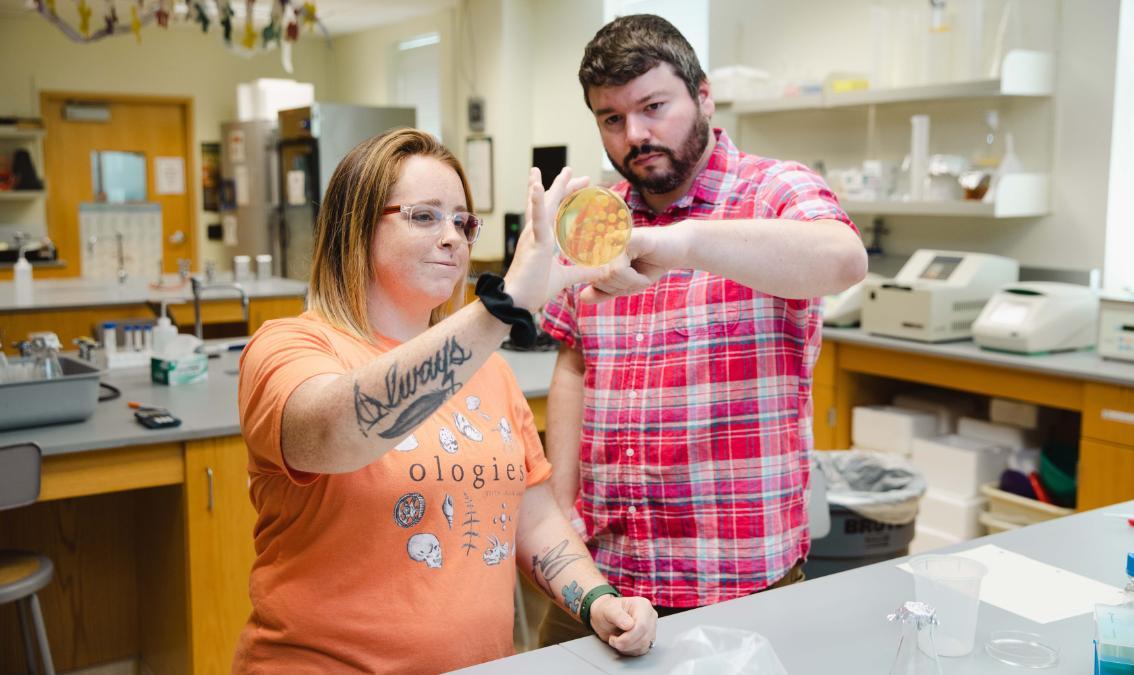This year we are catching up with the students who are engaged in PRISM research to highlight their work. Jammie McMurtry ’24, a transfer student from Norfolk majoring in chemistry with a concentration in biochemistry, is working with Dr. Jonathan White and studying platinum-based cancer treatments in an effort to improve them.
Tell us a little bit about your research project. What are you investigating?
I’m working with Dr. White, who has done research on different platinum-based compounds in cancer treatments. There are three platinum-based drugs, which means they have platinum cores, that have been approved by the FDA since the 1970s. We are researching different platinum-based compounds and their toxicity to cells. When cancer patients get chemotherapy treatment, a lot of people get really sick. That’s because the chemo is targeting these healthy cells as well as the cancer cells. So we are trying to find something that would potentially target more cancer cells than healthy cells.

Tell me about the fluorescent microscope you’ve been using.
Dr. White got the fluorescent microscope last fall, and we’ve been using it this summer in our PRISM work. We’ve been branching out into cell biology and cell metabolism and learning a lot of that for the first time. I know Dr. White is going to incorporate using fluorescence microscopy in his biochemistry classes. There are molecules that we’ve synthesized that are commonly used and not fluorescence. We introduce them to a cell culture and then that molecule is taken up by the cells and partially metabolized. The cell’s enzymes react and convert part of the molecule to a fluorescent state. Healthy cells have a membrane that will trap the fluorescent form in the cell. Then we can use the fluorescent microscope to identify living healthy cells. We might be able to identify a certain number of cells in the culture, and we might actually be able to quantify how many of those cells are normal, healthy living cells. That helps us understand what’s happening with our cancer drugs.
What have you found? Have you had success?
Yes. We are doing different things in yeast so that we can monitor the culture of the yeast and the different concentrations of the cancer drug over a fixed period of time. So we are looking into the drug’s ability to kill the yeast, or the platinum’s ability to kill the yeast. Living cells have certain characteristics, and when you treat them with drugs they die. One of the simplest ways to determine what’s happening is to look at their nucleus. A cell that is not well or is undergoing death has a different-looking nucleus. Its nucleus is starting to fragment. But you can’t just look and see a cell nucleus. That’s where the fluorescent microscope comes in. We introduce the fluorescent markers into the sample, and then they bind to the DNA. So when you shine light at it, it shines light back at you. You can detect that light, and that’s what the microscope does—it detects the florescence.
What is your favorite part of doing PRISM research?
I’ve never gotten to do research before. So I think my favorite part is just being able to get my foot in the door because I want to do research after Longwood. I really like the fluorescent microscope. It’s really cool. Learning the different techniques and using different instruments will help me when I move on to grad school. Eventually I want to work in a field called proteomics, which is looking at DNA and biomarkers. So this is a great start for me because I’m learning how to track different things.
How does your PRISM experience differ from your experience during the semester?
It’s a lot different from my classroom labs. I really enjoy it because I get to ask a lot of different questions that I don’t typically get to ask in a structured lab environment. In an educational lab, the professor already has the answer. The point is for you to learn how to do those things, and you get the answer at the end in your lab protocol. We don’t have an answer at the end for this. Dr. White is very informative and has led me in all of the right directions to try to find research to get answers, and that’s different from being in a lab classroom.
Why would you recommend doing PRISM to other students?
It’s such a valuable program. As a chemistry major, research is very important. I actually chose Longwood over Old Dominion University because Longwood is small and one benefit is I get to do a lot of this one-on-one research. PRISM, my senior thesis, and just doing research with professors, all of that builds my resume for grad school. You also get to know your professors, and that comes in handy for letters of recommendation. I didn’t know about PRISM until Dr. Sarah Porter mentioned it to me and encouraged me to apply. Biochemistry is a new concentration here, and I was the first student who declared in the program. It’s awesome to work with Dr. White and help build the biochem program.



Leave a Comment